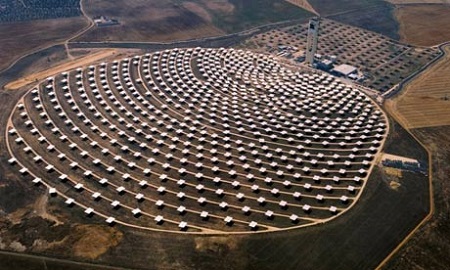Solution for: Out of Africa: Saharan Solar Energy
Answer Table
| 1. E | 8. E |
| 2. B | 9. A |
| 3. G | 10. mirrors |
| 4. A | 11. steam |
| 5. E | 12. depressions |
| 6. F | 13. irrigation |
| 7. G |
Exam Review
Out of Africa: Saharan Solar Energy

Vivienne Wait reports on how the Sahara Desert could offer a truly green solution to Europe’s energy problems
A
For years, the Sahara has been regarded by many Europeans as a terra incognita* of little economic value or importance. But this idea may soon change completely. Politicians and scientists on both sides of the Mediterranean are beginning to focus on the Sahara’s potential to provide power for Europe in the future. They believe the desert’s true value comes from the fact that it is dry and empty. Some areas of the Sahara reach 45 degrees centigrade on many afternoons. It is, in other words, a gigantic natural storehouse of solar energy.
B
A few years ago, scientists began to calculate just how much energy the Sahara holds. They were astonished at the answer. In theory, a 90,600 square kilometre chunk of the Sahara - smaller than Portugal and a little over 1% of its total area - could yield the same amount of electricity as all the world’s power plants combined. A smaller square of 15,500 square kilometres - about the size of Connecticut - could provide electricity for Europe’s 500 million people.
'I admit I was sceptical until 1 did the calculations myself,’ says Michael Pawlyn, director of Exploration Architecture, one of three British environmental companies comprising the Sahara Forest Project, which is testing solar plants in Oman and the United Arab Emirates. Pawlyn calls the Sahara’s potential ’staggering’.
C
At the moment, no one is proposing the creation of a solar power station the size of a small country. But a relatively well-developed technology exists, which proponents say could turn the Sahara’s heat and sunlight into a major source of electricity - Concentrating Solar Power (CSP], Unlike solar panels, which convert sunlight directly into electricity, CSP utilises mirrors which focus light on water pipes or boilers to produce very hot steam to operate the turbines of generators. Small CSP plants have produced power in California’s Mojave Desert since the 1980s. The Sahara Forest Project proposes building CSP plants in areas below sea level (the Sahara has several such depressions) so that sea water can flow into them. This water would then be purified and used for powering turbines and washing dust off the mirrors. Waste water would then supply irrigation to areas around the stations, creating lush oases - hence the ’forest’ in the group’s name.
D
But producing Significant quantities of electricity means building huge arrays of mirrors and pipes across hundreds of miles of remote desert, which is expensive. Gerry Wolff, an engineer who heads DESERTEC, an international consortium of solar-power scientists, says they have estimated it will cost about $59 billion to begin transmitting power from the Sahara by 2020.
E
Building plants is just part of the challenge. One of the drawbacks to CSP technology is that it works at maximum efficiency only in sunny, hot climates - and deserts tend to be distant from population centres. To supply Europe with 20% of its electricity needs, more than 19,300 kilometres of cables would need to be laid under the Mediterranean, says Gunnar Asplund, head of HVDC research at ABB Power Technologies in Ludvika, Sweden. Indeed, to use renewable sources of power, including solar, wind and tidal, Europe will need to build completely new electrical grids. That’s because existing infrastructures, built largely for the coal- fired plants that supply 80% of Europe’s power, would not be suitable for carrying the amount of electricity generated by the Sahara. Germany’s government-run Aerospace Centre, which researches energy, estimates that replacing those lines could raise the cost of building solar plants in the Sahara and sending significant amounts of power to Europe to about $485 billion over the next 40 years. Generous government subsidies will be needed. ‘Of course it costs a lot of money,’ says Asplund. ‘It’s a lot cheaper to burn coal than to make solar power in the Sahara.’
F
Meanwhile, some companies are getting started. Seville engineering company Abengoa is building one solar- thermal plant in Algeria and another in Morocco, while a third is being built in Egypt by a Spanish-Japanese joint venture. The next step will be to get cables in place. Although the European Parliament has passed a law that aids investors who help the continent reach its goal of getting 20% of its power from renewable energy by 2020, it could take years to create the necessary infrastructure.
G
Nicholas Dunlop, secretary-general of the London-based NGO e-Parliament, thinks companies should begin transmitting small amounts of solar power as soon as the North African plants begin operating, by linking a few cable lines under the Med. 'I call it the Lego method,’ he says. ‘Build it piece by piece.’ If It can be shown that power from the Sahara can be produced profitably, he says, companies and governments will soon jump in. If they do, perhaps airplane passengers flying across the Sahara will one day count the mirrors and patches of green instead of staring at sand.
adapted from Time Magazine
*terra incognita - Latin, meaning ‘an unknown land'
Questions 1-5
The reading passage has seven paragraphs, A-G.
Which paragraph contains the following information?
Write the correct letter, A-G.
NB You may use any letter more than once.
1 a mention of systems which could not be used
Answer: E
2 estimates of the quantity of power the Sahara could produce
Answer: B
3 a suggestion for how to convince organisations about the Sahara’s potential
Answer: G
4 a short description of the Sahara at present
Answer: A
5 a comparison of the costs of two different energy sources
Answer: E
Questions 6-9
Look at the following statements (Questions 6-9) and the list of organisations below.
Match each statement with the correct organisation, A-G.
6 They have set a time for achieving an objective.
Answer: F
7 They believe that successful small-scale projects will demonstrate that larger projects are possible.
Answer: G
8 They have a number of renewable energy projects under construction.
Answer: E
9 They are already experimenting with solar- energy installations in other parts of the world.
Answer: A
List of Organisations
A Exploration Architecture
B DESERTEC
C ABB Power Technologies
D Aerospace Centre
E Abengoa
F The European Parliament
G e-Parliament
Questions 10-13
Complete the summary below.
Choose NO MORE THAN TWO WORDS from the passage for each answer.
Concentrating Solar Power (CSP)
Unlike solar panels, CSP concentrates the sun's rays on boilers by using 10 .
Answer: mirrors
The resulting heat produces high-temperature 11 , which in turn moves the turbines which generate electricity.
Answer: steam
CSP plants will be situated in 12 to allow sea water to run in.
Answer: depressions
This, when purified, can be used to wash the equipment.
The resulting dirty water will be used for 13 around the power plant, and in this way oases will be formed.
Answer: irrigation
Other Tests
-
Total questions: 14
- 5- YES-NO-NOT GIVEN
- 9- Sentence Completion
-
Total questions: 14
- 5- YES-NO-NOT GIVEN
- 4- Sentence Completion
- 5- Summary, form completion
-
-
Total questions: 13
- 4- YES-NO-NOT GIVEN
- 4- Matching Information
- 5- Summary, form completion
-
Total questions: 14
- 6- YES-NO-NOT GIVEN
- 5- Sentence Completion
- 3- Summary, form completion
-
Total questions: 13
- 5- TRUE-FALSE-NOT GIVEN
- 3- Matching Information
- 5- Sentence Completion











